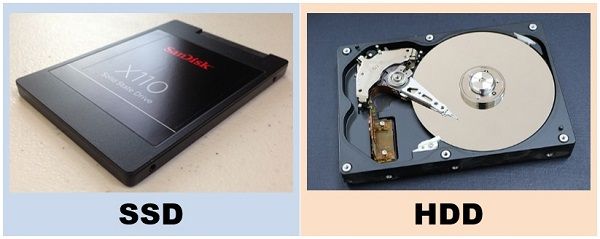

For example, the Intel SSD D5-P5316 is a 15.36TB enterprise-grade SSD that offers over 7000 MB/s in bandwidth. This leads to shorter wait times when you’re starting up and fewer delays when opening apps or doing heavy computing tasks.

Across the board, SSDs outpace HDDs because they use electrical circuitry and have no physical moving parts. What makes SSDs an increasingly popular choice is their speed. SSDs are more expensive than HDDs per amount of storage (in gigabytes (GB) and terabytes (TB)), but the gap is closing as SSD prices decline at a faster pace that HDD prices year over year. And SSDs dramatically reduce access time since users don’t have to wait for platter rotation to start up. Their capacity-or how much data they can hold-varies, making them flexible for smaller devices, such as slim laptops, convertibles, or 2 in 1s. Without the need for a spinning disk, SSDs can reduce to the shape and size of a stick of gum (what’s known as the M.2 form factor) or even as small as a postage stamp. This difference from HDDs has a lot of implications, especially in size and performance. In an SSD, all data is stored in integrated circuits. SSDs got their name-solid state-because they use solidstate devices under the hood.

In general, they are lower in cost and are practical for data that does not need to be accessed frequently, such as backups of photos, videos or business files. They are available in two common form factors: 2.5 inch (commonly used in laptops) and 3.5 inch (desktop computers). HDDs are considered a legacy technology, meaning they’ve been around longer than SSDs. The arm moves the heads across the surface of the disk to access different data. It is similar to how a turntable record player works, with an LP record (hard disk) and a needle on an arm (transducers). The HDD has an arm with several "heads" (transducers) that read and write data on the disk. It has spinning disks inside where data is stored magnetically. What Is an HDD?Īn HDD is a data storage device that lives inside the computer.
Define hard disk drive how to#
Here's a quick guide on the best use for each and how to compare. Solid state drives (SSDs) and hard disk drives (HDDs) are the two main storage options to consider. The type of storage your computer uses matters for performance, including power usage and reliability. Choosing the right storage isn’t just about comparing capacity and cost.


 0 kommentar(er)
0 kommentar(er)
